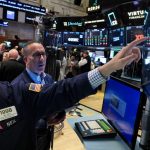
NEW YORK (Reuters) -Hopes that a rout in Treasuries has run its course are tempting some investors back into the U.S. stock market after a months-long selloff.
The relationship between stocks and bonds has been a tight one in recent months, with equities falling as Treasury yields climbed to 16-year highs. Higher yields offer investment competition to stocks while also raising the cost of capital for companies and households.
Over much of the last week, however, that dynamic has reversed, following news of smaller than expected U.S. government borrowing and signs that the Federal Reserve is nearing the end of its rate hiking cycle.
Yields on the benchmark 10-year US Treasury, which move inversely to bond prices, are down about 35 basis points from 16-year highs hit in October. Meanwhile, the S&P 500 surged 5.9% in the past week, its biggest gain since November 2022. The index is off around 5% from its July peak, though up nearly 14% year-to-date.
“The stability in rates is helping other asset classes find a footing,” said Jason Draho, head of asset allocation Americas at UBS Global Wealth Management. “If equities move higher you may find investors starting to feel as if they need to chase performance through the end of the year.”
Draho expects the S&P 500 to trade between 4,200 and 4,600 until investors determine whether the economy will be able to avoid a recession. The index was recently around 4,365.
Other factors may also be working in stocks’ favor. Exposure to equities among active money managers stands near its lowest level since October 2022, according to an index compiled by the National Association of Active Investment Managers – a compelling sign for contrarian investors who seek to buy when pessimism rises.
Aggregate equity positioning tracked by Deutsche Bank fell to a five-month low earlier in the week, the firm’s strategists said in a Friday note, helping fuel a powerful bounce when investors rushed back into the market.
At the same time, the last two months of the year have tended to be a strong stretch for stocks, with the S&P 500 rising an average of 3%, according to data from CFRA Research. The best two weeks of the year for the index, during which it has risen an average of 2.2% – kicked off on Oct. 22, according to data from Carson Investment Research.
“We had an extremely oversold market in the midst of a strong economy, and the Fed coming out a little more dovish was the kindling we needed for a rally,” said Ryan Detrick, chief market strategist at Carson Investment Research, who believes the current rebound in stocks will take them past their July high.
Bullish sentiment received another boost on Friday from U.S. employment data, which showed a slight gain in the unemployment rate and smallest wage increase in 2-1/2 years, suggesting that the labor market is cooling, bolstering the case for the Fed to stay its hand. The S&P 500 closed up 0.9% on the day.
Of course, plenty of investors remain hesitant to return to stocks just yet. Technology bellwether Apple Inc (NASDAQ:AAPL) on Thursday was the latest of the market’s massive technology and growth stocks to offer an underwhelming outlook. The iPhone maker gave a holiday sales forecast that was below Wall Street estimates. At least 14 analysts cut their price targets for the stock, according to LSEG data.
Still, analysts expect earnings growth of 5.7% for S&P 500 companies in the third quarter, with over 81% of the 403 companies in the benchmark index that have reported profits so far having beaten estimates, per LSEG data.
At the same time, betting on reversals in Treasuries has been a losing proposition for most of the year, during which rebounds in the U.S. government bond market have been followed by deeper selloffs. The 10-year Treasury yield is up around 125 basis points from its low for the year.
Some investors also worry that the so-called Goldilocks economy suggested by Friday’s jobs report may not last. Greg Wilensky, head of U.S. fixed income at Janus Henderson Investors, believes that while signs of softer than expected growth are boosting stocks and bonds for now, they may eventually stir recession worries.
“Eventually ‘good’ moderation may turn into a debate of whether the economy and labor markets are weakening too much,” he said.
To read the full article, Click Here

